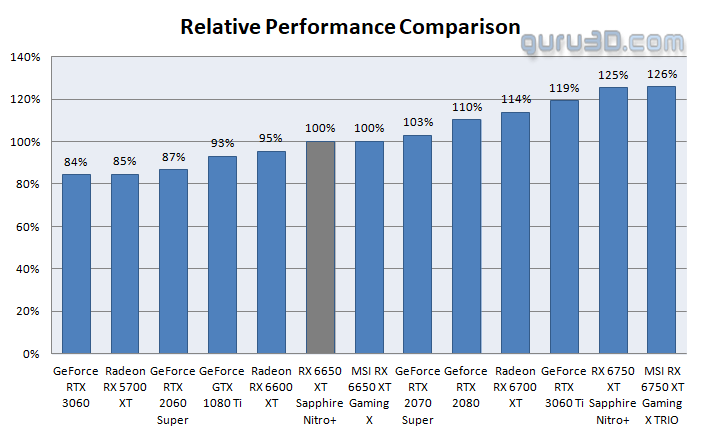Final words and conclusion
Final words
The 6650 XT is an attractive smallish graphics card in the Full HD and even WQHD domain. However seen from a bigger picture, coming from the 6600 XT it's just marginally faster and hardly worth your money, especially when compared to other that 6600 XT. AMD increased the memory clock to 2190 MHz effectively bringing in 17.5 Gbps of bandwidth. Next to that the core clock has been increased a notch, and for this AIB partner that shows itself to be a 2694 MHz max boost clock. The rest, unfortunately, all else is the same - aside from a concurrent increase in TGP which now hovers at roughly 200 Watts for the entire board including cooling. This is a splendid gaming card for Full HD and even WQHD. While FSR and RSR now help out, we just don't comprehend that AMD hasn't implemented dedicated machine learning super-sampling hardware like NVIDIA's Tensor cores. For factors like RT perf and the absence of MLAA, we question AMD's 399 USD starting pricing. Even with GDDR6 at 17.5 Gbps and the 128-bit memory bus, modern AMD GPUs are starved memory bandwidth due to the 128-bit wide memory bus. Once that smart cache runs dry, it will bite this product every time in the toosh as the GPU is constrained in memory bandwidth.
Performance spread reference
Consider the following comparison of various graphics cards in a certain price-performance range: Consider the table below to observe how the changes between the top and bottom are imperceptible. This week, we're featuring three 6x50 XT goods (other AIB cards will go live as well). Due to AMD's lack of a reference card, we clocked the 6650 XT entry closer to reference values. While these are not precise measurements, we estimate that the difference between the reference and factory-tuned models tested is around 2~3%. The performance difference between a reference 6600XT and 6500 XT we calculate to be 5%
The RX 6650XT is not without flaws. To convert a high-end Big NAVI core into a more cost-effective mid-range product some significant compromises were made. With only forty first-generation Ray Tracing cores, individuals interested in Ray Tracing will be more impressed by NIVIDIA's GeForce RTX 3060Ti, actually, the GeForce RTX 3070s will be a much better starting point. Furthermore, we're getting dangerously near to the predicted RDNA 3 / RX 7000 / Navi 3X release timeframe of late this year / early next year.
Cooling & acoustic
Sapphire's card works just fantastic, it simply does not make noise, even in its performance configuration. Heat levels sit just north of 65 Degrees C under hefty load, so that ain't an issue either.
Energy
Heat output and energy consumption are closely related to each other, as (graphics) processors and heat can be perceived as a 1:1 state; 250 Watts in energy consumption approaches close to 250 Watts in heat as output. This is the basis of TDP. AMD is listing the card at 180W, which is okay at best for a graphics card in the year 2022. We measure numbers slightly above the XT's advertised values; we measure the entire power consumption of the card to close in at ~200 Watt, that's total board power, not TGP.
Coil whine
Coil squeal hardly was present on the 6650 XT, just as it is on any other card these days, albeit to a smaller extent than usual. Is it a bothersome annoyance? It is, without a doubt, at a volume that is difficult no concern. This type of noise would be muffled in a closed chassis and fade into the background. With an open chassis, on the other hand, you may hear coil whine/squeal. In some way or another, all graphics cards do this, especially when running at higher frame rates; this can be perceived.
Pricing
AMD has done a great job with NAVI23. However, the price of an entry-level to mainstream graphics card has risen to $399. Too pricy? Yes, we agree. The cards sits close to RTX 3060 and 5700 XT performance, but only in shading performance. Raw Raytracing's performance lags behind the competitors.
Tweaking
The RX 6600 XT enjoys having more memory bandwidth available to it. You can add it manually and get up to 18.5 or if you are lucky 19 Gbps; however, results will vary depending on the board, brand, and even card due to cooling (GDDR6/GPU/VRM) and other factors. With a little GPU tweaking, we could get this AMD Navi GPU to run at a very respectable 2700~2800 MHz. And that's without any anomalies or crashes of any kind. The dynamic clock frequency is now hovering in the 2750 MHz range, depending on the load, game/app, and board assigned power. Even so, that's quite a feat. As is always the case, all of your tweaking and increased energy consumption will only provide you with a maximum of ~5% improvement in performance (depending on your results and model graphics card). It must successfully complete four-game runs (in four different games) in 2560x1440 resolution in order to be considered stable enough to be listed here.
Conclusion
The RX 6650 XT's base design is sound; especially considering what Sapphire did do to it, is nice. The performance improvements over the 6600 XT are minor. So all even that in any real-world gaming setting, you couldn't discern the difference between the two cards. I'd like to remind you that this card is a refresh and is intended to replace the market's 6600 XT. However, it is more expensive than the 6600 XT. What AMD should have done here is to swap out the 6600 XT with the 6650 XT and keep pricing the same. AMD made memory subsystem decisions limited memory bandwidth (128-bit); by including 32MB of L3 cache, AMD has circumvented the majority of that limitation, and the card performs flawlessly up to 1920x1080; however, L3 cache will always be a bypass, a short-cut to a problem that may recur in the future. Due to the severely constrained memory interface, performance will degrade immediately upon the cache drying out. AMD's raytracing technology also may not perform as well as its competitors, it is still useful for "fooling about a bit." We feel that RSR can be a great help for you to gain some additional free performance. But free is never free, and image quality can be a compromise you need to make. It must be said, though, that this is a fun choice to have and explore with. If not for the outrageous price, this would still be an attractive and gorgeous product at the 1920x1080 resolution; nevertheless, the price is simply too much. To be considered, the product's pricing has to be less than $300 USD. I recognize that you may disagree with and could challenge my views. The card overall performs as quickly as or slightly quicker than an RTX 3060 or even faster than the Ti. However the card series is priced similarly to the $399 3060 Ti. For games that support DLSS, the Geforce 3060 Ti is always the obvious winner. To summarize, the Radeon RX 6650 XT series remains a fun gaming card series focused entirely on rasterized shading; at Full HD and even WQHD resolutions, the 32MB L3 cache shines. You may play around with raytracing a little bit to get a glimpse into future gaming quality. The high asking price remains a significant red flag, especially when considering product positioning and relative performance. Sapphire did an excellent job with the Nitro+X design and implementation; you will receive a device that is quiet, sleek, and trendy. However, as a refresh from AMD, it feels a little pointless.
Sign up to receive a notification when we publish a new article.
Or go back to Guru3D's front page.
- Hilbert, LOAD"*",8,1.


